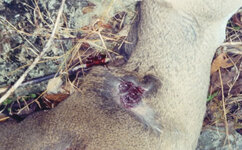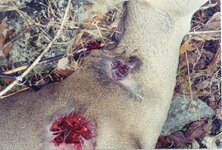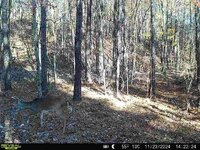Navigation
Install the app
How to install the app on iOS
Follow along with the video below to see how to install our site as a web app on your home screen.
Note: This feature may not be available in some browsers.
More options
Style variation
You are using an out of date browser. It may not display this or other websites correctly.
You should upgrade or use an alternative browser.
You should upgrade or use an alternative browser.
.223, 6mm, and 6.5 failures on big game
- Thread starter Dave0317
- Start date
- Joined
- Oct 22, 2014
- Messages
- 13,519
I neck shot a small buck Thursday afternoon with a 73gr Eldm out of a 20in 223. Never found him. He showed on on the game camera today. You can see where I hit him. I guess that will be my last neck shot.
The spine is low where it meets the body cavity. That placement is well above it.
OneGunTex
Lil-Rokslider
The spine is low where it meets the body cavity. That placement is well above it.
Are you surprised that the wound channel did not fracture the spine with that bullet and placement? Would a different caliber/bullet have produced different results?
I grew up taking neck shots on deer with what were at the time high-velocity cartridges that supposedly produced "shock". Personally switched to lung/heart shots to give me more margin of error in more random field conditions, but I have family that still mainly does it because it makes less of a mess. The above post certainly looks to qualify as "bullet failure" to me
If you don't hit bone, all you have above the spinal column is flesh. Looks like a pretty thin necked deer so you may not have enough flesh to initiate fragmentation before you pass the spine so all you get is a flesh wound with a tiny entrance and larger exit.Are you surprised that the wound channel did not fracture the spine with that bullet and placement? Would a different caliber/bullet have produced different results?
I grew up taking neck shots on deer with what were at the time high-velocity cartridges that supposedly produced "shock". Personally switched to lung/heart shots to give me more margin of error in more random field conditions, but I have family that still mainly does it because it makes less of a mess. The above post certainly looks to qualify as "bullet failure" to me
Jay
- Joined
- Oct 22, 2014
- Messages
- 13,519
Are you surprised that the wound channel did not fracture the spine with that bullet and placement?
No.
Would a different caliber/bullet have produced different results?
Not likely. Though the 73gr ELD-M does not produce quite as wide of wounds as the 77gr TMK.
I grew up taking neck shots on deer with what were at the time high-velocity cartridges that supposedly produced "shock". Personally switched to lung/heart shots to give me more margin of error in more random field conditions, but I have family that still mainly does it because it makes less of a mess.
Sure. However, the neck has a lot of space that isn’t fatal.
Bullet failure? If you are stating that, you have a lack of understanding of actual terminal ballistics and animal anatomy.The above post certainly looks to qualify as "bullet failure" to me
Is this bullet failure from a 300 Win mag?

Lawnboi
WKR
A small neck may not give the depth needed for upset. Depends on bullet, but they all don’t upset immediately. Most of the reason I don’t take neck shots. Small target especially on a doe.
OneGunTex
Lil-Rokslider
Geez don't make this personal. You'll note that I appended that to a couple of questions about relative performance.Bullet failure? If you are stating that, you have a lack of understanding of actual terminal ballistics and animal anatomy.
If he expected a dead deer from that shot with that bullet, and he didn't miss, he should be forgiven for seeing it as a failure. That's what this thread is for, isn't it? For examples of where a 223 shot into an animal didn't kill it?
You posted a pic of a dead deer shot in the neck with a 300 WM. That's a success. I've killed/seen dozens of deer killed with neck shots. Success. Which begs the question why his shot "failed." A reasonable answer is "hit a nonvital area", but clearly that isn't /always/ the case, so "terminal ballistics" are a little more complicated than you make it out to be.
- Joined
- Oct 22, 2014
- Messages
- 13,519
Geez don't make this personal. You'll note that I appended that to a couple of questions about relative performance.
I didn’t make it personal. I was being short as I responded while glassing for deer.
If he expected a dead deer from that shot with that bullet, and he didn't miss, he should be forgiven for seeing it as a failure. That's what this thread is for, isn't it? For examples of where a 223 shot into an animal didn't kill it?
? There’s nothing to forgive. That placent likely wouldn’t have killed that deer regardless of caliber.
You posted a pic of a dead deer shot in the neck with a 300 WM. That's a success.
Negative. That shot was 18 hours prior to the shot that actually killed the deer-

Shot in the neck the evening prior at last light. The deer dropped, then got back up and ran into the brush as it was approached. Left it overnight, and it was jumped a couple of hundred yards from the initial shot. The shot in the chest was the second shot. The first shot was above the spine- was not fatal and the deer would have survived it unless infection set in.
I've killed/seen dozens of deer killed with neck shots. Success
I’ve shot a lot of deer in the neck, and have seen a lot more shot in the neck by others- a lot. Neck shots are not the “sure thing” that people believe them to be.
. Which begs the question why his shot "failed." A reasonable answer is "hit a nonvital area", but clearly that isn't /always/ the case, so "terminal ballistics" are a little more complicated than you make it out to be.
I’m not sure that terminal ballistics is more complicated. It is simply that bullets react certain ways in tissue, and tissue reacts to the bullets. If you do not strike something vital (and 90% of the neck isn’t immediately vital), then animals tend to not die.
LIWolverine
WKR
6.5 Grendel Hornady Black 123gr ELDM. Arkansas whitetail doe. 110 yards broadside. Shot low in the shoulder. Slow mo video shows bullet deflect down into the dirt. No chest cavity.
First pic you can see white “smoke” (bullet and hair). Second pic you can see where the leg is broken and folded up when she jumped.
Blood and bone fragments. Trailed sparse blood for over 300 yards into the next morning. Trail shows where she was jumped by run by coyotes. Blood from night before was dry. Jumped spot blood was wet and recent.
W


First pic you can see white “smoke” (bullet and hair). Second pic you can see where the leg is broken and folded up when she jumped.
Blood and bone fragments. Trailed sparse blood for over 300 yards into the next morning. Trail shows where she was jumped by run by coyotes. Blood from night before was dry. Jumped spot blood was wet and recent.
W


- Joined
- Oct 22, 2014
- Messages
- 13,519
6.5 Grendel Hornady Black 123gr ELDM. Arkansas whitetail doe. 110 yards broadside. Shot low in the shoulder. Slow mo video shows bullet deflect down into the dirt. No chest cavity.
First pic you can see white “smoke” (bullet and hair). Second pic you can see where the leg is broken and folded up when she jumped.
Blood and bone fragments. Trailed sparse blood for over 300 yards into the next morning. Trail shows where she was jumped by run by coyotes. Blood from night before was dry. Jumped spot blood was wet and recent.
W

Did you find the deer?
LIWolverine
WKR
[QUOTE="]Did you find the deer?[/QUOTE]
No sir. Couldn’t get a dog.
I’m still a huge fan of yr old son was the shooter. Still getting him used to holding lungs instead of heart with that round. Bone hit definitely caused it.
Sent from my iPhone using Tapatalk Pro
No sir. Couldn’t get a dog.
I’m still a huge fan of yr old son was the shooter. Still getting him used to holding lungs instead of heart with that round. Bone hit definitely caused it.
Sent from my iPhone using Tapatalk Pro
Last edited by a moderator:
Your post lost its mind!I don’t know what the heck just happened with that post.
No sir. Couldn’t get a dog.
Huge fan of [emoji[emoji[emoji[emoji6
]
[emoji6
]][emoji
[emoji[emoji6
]
][emoji[emoji6
]
]]][emoji[emoji
[emoji[emoji6
]
[emoji6
]][emoji
[emoji[emoji6
]
][emoji[emoji6
]
]]]
[emoji[emoji6
]
[emoji6
]][emoji
[emoji[emoji6
]
][emoji[emoji6
]
[emoji6
]]]][emoji[emoji6
]
[emoji6
]][emoji[emoji
[emoji[emoji6
]
[emoji6
]][emoji
[emoji[emoji6
]
][emoji[emoji6
]
]]][emoji[emoji
[emoji[emoji6
]
[emoji6
]][emoji
[emoji[emoji6
]
][emoji[emoji6
]
]]]
[emoji[emoji6
]
[emoji6
]][emoji
[emoji[emoji6
]
][emoji[emoji6
]
[emoji6
]]]][emoji[emoji6
]
[emoji6
]][emoji
[emoji[emoji6
]
[emoji6
]][emoji
[emoji[emoji6
]
][emoji[emoji6
]
]]]]].[emoji[emoji
[emoji[emoji6
]
[emoji6
]][emoji
[emoji[emoji6
]
][emoji[emoji6
]
]]][emoji[emoji
[emoji[emoji6
]
[emoji6
]][emoji
[emoji[emoji6
]
][emoji[emoji6
]
]]]
[emoji[emoji6
]
[emoji6
]][emoji
[emoji[emoji6
]
][emoji[emoji6
]
[emoji6
]]]][emoji[emoji6
]
[emoji6
]][emoji[emoji
[emoji[emoji6
]
[emoji6
]][emoji
[emoji[emoji6
]
][emoji[emoji6
]
]]]
[emoji[emoji6
]
[emoji6
]][emoji
[emoji[emoji6
]
][emoji[emoji6
]
[emoji6
]]]]] just didn’t work on that shot to the shoulder. My [emoji
[emoji[emoji6
]
][emoji[emoji6
]
[emoji6
]]][emoji
[emoji[emoji6
]
][emoji[emoji6
]
[emoji6
]]] yr old son was the shooter.
Sent from my iPhone using Tapatalk Pro
Jay
BigNate
WKR
Not trying to insult at all, but the fact that there was that much white hair in the air while she was still motionless makes me believe that hit was through the leg maybe, but cut the brisket.
My son made a similar shot with his 243 and we never found it.
My son made a similar shot with his 243 and we never found it.
LIWolverine
WKR
Big Nate
Video shows impact just forward in the shoulder but above chest line, then bullet deflects down.
Not an ideal shot by any means but I know other rounds and most likely other bullets in the same round that would have busted through instead of deflecting.
My 11yr old was the shooter. Still training him to hold
off shoulder for double lung instead of tight on the heart.
Sent from my iPhone using Tapatalk Pro
Video shows impact just forward in the shoulder but above chest line, then bullet deflects down.
Not an ideal shot by any means but I know other rounds and most likely other bullets in the same round that would have busted through instead of deflecting.
My 11yr old was the shooter. Still training him to hold
off shoulder for double lung instead of tight on the heart.
Sent from my iPhone using Tapatalk Pro
- Joined
- Oct 22, 2014
- Messages
- 13,519
Big Nate
Video shows impact just forward in the shoulder but above chest line, then bullet deflects down.
Not an ideal shot by any means but I know other rounds and most likely other bullets in the same round that would have busted through instead of deflecting.
My 11yr old was the shooter. Still training him to hold
off shoulder for double lung instead of tight on the heart.
Sent from my iPhone using Tapatalk Pro
So a piece of flat cardboard stoped a bullet and turned it 90°?
And you logically believe that is more likely than the video being deceiving, and the shot going a little lower than suspected?
LIWolverine
WKR
Not at all. I think impact was on orange x.
I don’t think a shoulder BLADE could stop that bullet ever at that range.
New shooter making a bad shot happens. We didn’t get to recover the deer so I’ll never know for sure. All I know is what I can see on the video and the facts of the round, yardage, rifle and shooter. Angle of video can definitely deceive us and stuff isn’t always as it appears.
Like I said in my jacked up post, I’m a huge fan of the 6.5. It’s my go to as a PRC and 6.5-284 for all my hunting the last two years.

Sent from my iPhone using Tapatalk Pro
I don’t think a shoulder BLADE could stop that bullet ever at that range.
New shooter making a bad shot happens. We didn’t get to recover the deer so I’ll never know for sure. All I know is what I can see on the video and the facts of the round, yardage, rifle and shooter. Angle of video can definitely deceive us and stuff isn’t always as it appears.
Like I said in my jacked up post, I’m a huge fan of the 6.5. It’s my go to as a PRC and 6.5-284 for all my hunting the last two years.

Sent from my iPhone using Tapatalk Pro
- Joined
- Oct 22, 2014
- Messages
- 13,519
Not at all. I think impact was on orange x.
I don’t think a shoulder BLADE could stop that bullet ever at that range.
New shooter making a bad shot happens. We didn’t get to recover the deer so I’ll never know for sure. All I know is what I can see on the video and the facts of the round, yardage, rifle and shooter. Angle of video can definitely deceive us and stuff isn’t always as it appears.
Like I said in my jacked up post, I’m a huge fan of the 6.5. It’s my go to as a PRC and 6.5-284 for all my hunting the last two years.
Sent from my iPhone using Tapatalk Pro
? That’s most likely where it hit, or slightly lower right. Either way, that’s out of the chest cavity.
What are the actual disadvantages? Say of using a 308 instead of a 223.They have potential for advantages, but do they always outweigh the disadvantages?
Ha ha ha you must be kidding. How does recoil effect your shooting while hunting? With a minor amount of practice and good form it shouldn't even bother you on the bench, Talking 308 Winchester.Recoil
Similar threads
- Replies
- 264
- Views
- 28K
Featured Video
Latest Articles
- TT#64 Josh Boyd Elk Hunting Strategies for Every Season
- Aaron Davidson of Gunwerks
- TT#63 Dirk Durham’s Art of Elk Calling
- BIG Buck Stories with the Dirty Giants Podcast
- TT#62 Brian Barney Hunting Bulls without Calling
- Hoyt Alpha AX-2 SD Review
- Kuiu Kenai vs Outdoor Vitals Vario Hooded Jacket Review
- Hoyt RX-9 Ultra Review
- Hunting Vampire Bucks & Building an Optics Kit
- Darton Sequel ST2 35 Review



 [emoji[emoji6
[emoji[emoji6
 ]][emoji
]][emoji